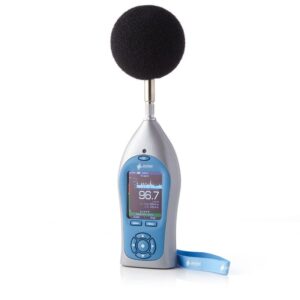Recommended products from Pulsar Instruments™
-

7-year
Warranty
NoisePen Personal Sound Exposure MeterFrom: £499.00 (Ex. VAT/GST) -

7-year
Warranty
Nova Noise at Work Sound Level MeterFrom: £1,605.00 (Ex. VAT/GST) -

7-year
Warranty
SafeEar Noise-activated Warning Sign – Hearing Protection Must Be WornFrom: £342.00 (Ex. VAT/GST)
The Noise at Work Regulations requires employers to carry out workplace noise monitoring (also known as an occupational noise assessment) as an essential part of their Health and Safety strategy to help combat the effects of workplace noise pollution on employees.
If you are a Safety Professional operating in a noisy work environment and tasked with this responsibility it might seem a complex task, but Pulsar Instruments is here to make it easier for you.
Firstly, it is always worth reminding yourself about what you are trying to achieve in order to safeguard the hearing of your workers:
“Minimising or avoiding the risk of noise-induced hearing loss in the workplace to comply with local, noise-based, up-to-date legislation”
Secondly, you need to gain an understanding of your responsibilities under such Noise Legislation or Regulations. In the European Union legislation is usually based on a European Directive that is then modified to suit the needs of each particular country, for example, in the United Kingdom, the ‘The Control of Noise at Work Regulations 2005’ are based on the European Union Directive 2003/10/EC “The physical agents (noise)” directive and expanded upon by the UK’s Health & Safety Executive. Other regions, countries and territories may have their own local rules.
Download our easy to follow Guide for Employers and find out about the different noise exposure limits.
“5 Steps to Controlling noise at work”
Find your perfect noise measurement equipment
Further information for workplace noise monitoring
What is noise-induced hearing loss (NIHL)?
NIHL is a permanent type of hearing loss caused by prolonged exposure to high levels of noise.
In NIHL, hearing can deteriorate gradually from exposure to excessive noise levels, or in rarer cases it can happen quickly, such as with Acoustic Shock or extremely high sudden noise like explosions for instance. The most common cause of NIHL is from noise at work. It is also associated with an increased occurrence of Tinnitus and other hearing conditions. In Europe, the USA and Canada there are strict regulations covering occupational noise exposure.
The extent of NIHL
One in six of the British population suffers from hearing loss.
Unfortunately, future projections do not look promising as it is estimated that, by the end of 2031, there will be 14.5 million people with hearing loss in the UK. NIHL occurs when someone is continuously exposed to loud or persistent excessive noise, whether when working or listening to loud music. According to the World Health Organisation, noise exposure is the main cause of permanent hearing damage in the workplace. It is also known as Industrial or Occupational Deafness. In the UK, research estimates that over 2 million people are exposed to noise levels at work that may be harmful. The Control of Noise at Work Regulations (2005) requires employers to prevent or reduce risks to health and safety from exposure to noise at work. It is worth noting that employees have duties under the Regulations too.
Statistics from the HSE in the UK estimated that there were 21,000 workers with work-related hearing problems, 2016/17 to 2018/19 [1]
How to protect workers and meet the regulations?
The first action should be to obtain and read your national regulations and any advice leaflet.
In the UK, both can be found in the HSE (Health and Safety Executive) booklet L108 ‘Controlling noise at work‘. This gives excellent and accurate advice in clearly marked sections. The data in the HSE booklet applies all over the European Union and is one of the best guides available in the English language.
Firstly, you need to establish if you do, or do not, have a noise problem in each of your main areas or work zones and assess the risk. There are a number of simple rules to determine this. However, to be absolutely safe, even if you are sure you do not have a noise problem, you would be advised to perform and document some simple noise measurements to provide long-term evidence of your basic workplace noise assessment.
Employers who do not realise how serious industrial deafness is and who may have inadvertently ignored the legislation may be facing significant claims in the future by employees for noise-induced hearing loss. It is worth noting that, in 2013, 60,000 claims notifications were recorded in the UK alone for noise-induced hearing loss; this was a significant increase in data since 2001. In 2018 the HSE recorded 55 new claims for work-related deafness [1], and there has been a general reduction from 2009 to 2018 which is great news, but the aim is for there to be Zero Cases.
There is no way of bringing back the hearing of workers affected but future claims can be avoided by limiting the exposure of noise to staff.
Limiting the exposure of noise to staff
A calibrated, easy to operate, noise or sound level meter such as the Pulsar Model 14, or Models 41 & 42 from the Pulsar Nova range would be an ideal choice to simplify the task of performing a basic noise assessment of noise levels.
As a crude guide, if you are in an area where the noise is intrusive but normal conversation is possible, this would have a probable noise level of around 80dB(A). If people are working in this environment for 6 hours or more, you would need to carry out a formal noise risk assessment. If you need to shout at someone who is about 2m away and this noise level occurs for 2 or more hours per day, you need to carry out a formal noise risk assessment.
| Level in decibels ‘A’ frequency weighted | Actions required to meet the regulations |
|---|---|
| Areas always < 75dB | Brief risk assessment only – no other action |
| Areas between 75 & 85dB for a proportion of the time | An initial survey using a Leq meter or noise dosemeter |
| Areas where levels are likely to give an 8-hour exposure of 80dB(A) or more. | A full survey with clear identification of levels & corresponding actions; ideally with noise sources listed and personal exposure estimates for all workers likely to be at risk from noise-induced hearing loss. |
Noisy workplaces aren’t always those with manufacturing or heavy industry, find out about managing and controlling noise in offices and call centres.
How to carry out a Noise Risk Assessment survey – the basics
Workplace noise monitoring compliant with noise legislation – noise risk assessment for noise in the workplace in Europe, once you have established that you have employees that are likely to receive an exposure of 80dB(A) or above, you need to carry out a formal occupational noise assessment.
To start your assessment of occupational noise exposure you need to measure workplace noise levels and for this, there are two equally acceptable methods. The first is by using a sound level meter and subsequently calculating exposure levels based on the duration of exposure to each noise source. The second uses a noise dosemeter, also known as a Personal Sound Exposure Meter (PSEM) to measure the exposure to noise of each individual.
Pulsar Instruments Plc makes both types of instrumentation with a choice to suit every budget. Each noise assessment method has its advantages but you need to decide which method is best suited to your specific task. Should you need any help, please contact one of our technical team who will be pleased to offer you advice and guidance. Often a combination of approaches gives the best results.
Once you’ve completed your risk assessment you will be required to make recommendations to minimise and mitigate any noise problems, such recommendations can include things like designating areas as mandatory hearing protection zones, installing noise-activated warning signs, engineering out noise and undertaking health surveillance of workers.
References
[1] HSE website http://www.hse.gov.uk/statistics/causdis/deafness/index.htm
